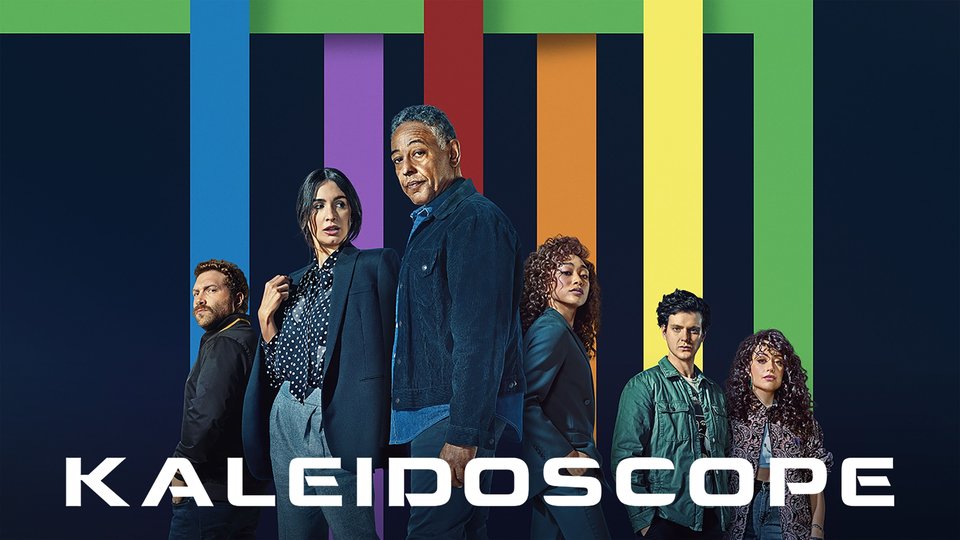Anyone who has ever taken a creative writing class is likely familiar with the lipogram: A piece of writing that entirely omits one or more letters. A poem without es or a vignette with no as, it forces the writer to experiment and to think outside of the box as an exercise in creative restraint. Episodic chronology is the screenwriter’s letter e. Take away the function of an episode, or distort a poet’s alphabet, and you can expect the making of something you’ve never seen before. The new Netflix original Kaleidoscope aims to do just that.
Released on Jan. 1, Kaleidoscope is an eight-episode heist story spanning the 25 years leading up to the theft of $70 billion and its aftermath. The appeal of the show is that the episodes can be watched regardless of order. Netflix randomizes the episodes for each viewer, who are dropped into the story unfettered by chronology. As a concept, Kaleidoscope is exciting and promises a new way of consuming stories. But when it comes to the viewing experience, very little is gained from the scrambled viewing order.
As streaming platforms compete to provide the largest quantity of content possible, quality inevitably takes its leave. Showrunners are now challenged to have their projects stand out amid an ocean of mediocrity. In turn, viewers have seen a recent rise in experimental television that bends the structure of a show to the viewer’s whim. Black Mirror’s choose-your-own-adventure style special, Bandersnatch, premiered on Netflix in 2018 and allowed viewers to alter an episode’s outcome by directly interacting with the plot. Bandersnatch found relative success and certainly tested the boundaries of what television is capable of. Similarly, Kaleidoscope pushes the envelope of narrative structure, specifically with the help of Netflix, which has been facilitating these new ways of consuming stories.
Overall, Kaleidoscope is not a bad show. It’s marginally entertaining, with solid performances from the cast and a snappy script. But I was disillusioned with the show’s experimentalism upon realizing that its only remarkable quality is the mixed-up timeline. To accommodate the lack of intentional episode order, the writers limit themselves significantly. Heist stories typically promise intricate, high-pressure plots, which are mostly relinquished in Kaleidoscope, since each episode needs to wrap up very neatly to avoid confusing the viewer. Character arcs become disjointed as their progression cannot rely on the show’s timeline. In terms of storytelling, these aspects of the show would have been strengthened with a traditional narrative structure. The fatal flaw, however, is that the intrigue of the format falls away almost immediately. I sincerely doubt that any viewer spends all eight episodes musing on how cool it is that they are watching it in a different order than someone else. All this begs the question of why the show even needed to be formatted this way.
The show’s preview, a 52-second opening clip explaining the concept and previewing the season, answers this almost instantly. The clip boasts the ‘epicness” of the show in a melodramatic tone that is inconsistent with what Kaleidoscope actually delivers. If the creators intended the preview to build anticipation, its effect is something more akin to a light-up applause sign. Right from the start, Netflix eagerly overcompensates for a lack of substance. The non-chronological concept of Kaleidoscope was pitched by creator Eric Garcia before the heist plot even came to be, so it’s no wonder that the story itself falls into the traps of Netflix’s marketing. Such a transparently desperate prelude, urging the viewer to appreciate the ultimately inconsequential format of the show, reveals an overreliance on gimmicks as a marketing tactic.
The creators of Kaleidoscope sacrifice good storytelling to create a shiny, money-grubbing trinket. They place too much emphasis on a concept that doesn’t hold up over the course of the show, becoming entirely irrelevant as the plot plays out. It’s cool, like a poem without e is cool. But what is cool for a show that is otherwise indiscernible from the mediocrity that already fills Netflix’s catalogue?








